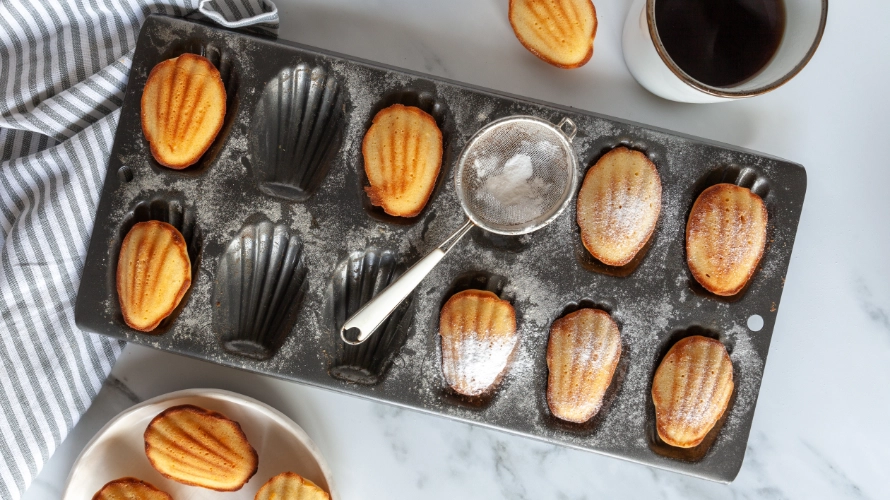Madeleines

Ingredients
- 2 egg
- 100 gr sugar
- 20 gr honey
- 100 gr unsalted butter
- 100 gr plain flour
- 3 gr baking powder
- 1 squeeze lemon juice
- 1 pinch salt
Equipment
- 1 mixing bowl (one for wet, one for dry)
- 1 sieve
- 1 spatula
Instructions
- 1. Prepare the egg mixtureCrack the eggs into a bowl and add the sugar. Whisk until pale, thick, and a bit frothy, this gets those lovely air bubbles going.
- 2. Incorporate honeyAdd the honey to your egg and sugar mixture and mix it in well. You want the sweetness smooth and evenly distributed.
- 3. Melt and flavour the butterIn a separate bowl, melt the butter. Mix in a squeeze of lemon juice and a pinch of salt, think of this as setting the stage for all that almondy, buttery aroma later.
- 4. Combine dry ingredientsSift the flour and baking powder together and add to the egg, sugar, and honey mixture. Stir gently until just incorporated.
- 5. Add the butterPour your melted, lemony butter into the batter and fold through with care. Don’t overwork it, gentle hands make fluffy cakes.
- 6. Rest the batterCover the bowl and let the batter rest in the fridge for at least 2 hours. This helps make that classic “hump”, the sign of a good madeleine!
- 7. Preheat and prepare your trayWhen you’re ready to bake, grease your madeleine tray with a bit of melted butter. Preheat the oven to 220°C.
- 8. Fill and bakeSpoon the batter into your tray, filling each shell about three-quarters full (the mixture will rise). Bake for 3 minutes at 220°C, then reduce the oven to 200°C and bake for another 7 minutes until golden and slightly domed in the middle.
- 8. Cool and enjoyPop them out of the Madeleines tray and, if you can resist, let them cool on a rack. The aroma alone makes it tough to wait, but the flavours come out better if you have some patience.
Notes
Drink pairing
Coffee or Tea!
About this recipe
Traditionally served at coffee or teatime (or whenever you need a hug in cake form), madeleines represent everything the French do best: elegance, simplicity, and just a little bit of buttery heaven. They are as French as the baguette! Born in the 18th century in the town of Commercy, Lorraine, legend has it a resourceful servant named Madeleine Paulmier first baked them for the exiled King Stanisław of Poland, who, perfectly on brand, demanded something completely new for his guests. The cakes shot to stardom when Louis XV’s wife, Maria Leszczyńska, took the recipe to Versailles, and soon every Parisian salon was serving little shell-shaped bites of joy.
Marcel Proust and the madeleine moment
No pastry has ever triggered more daydreaming in French literature than the humble madeleine, thanks to Marcel Proust. In his monumental novel In Search of Lost Time (À la recherche du temps perdu), Proust transforms the act of tasting a madeleine, soaked in tea, into one of the most famous passages in world literature.
The original scene
At the start of the first volume, “Swann’s Way,” the narrator, feeling a tad low on a winter afternoon, accepts a cup of tea and a petite madeleine from his mother. As he takes a spoonful, he is suddenly swept away by an overwhelming sensation:
“No sooner had the warm liquid mixed with the crumbs touched my palate than a shudder ran through me and I stopped, intent upon the extraordinary thing that was happening to me. An exquisite pleasure had invaded my senses […] And suddenly the memory revealed itself. The taste was that of the little piece of madeleine which on Sunday mornings at Combray […] my aunt Léonie used to give me, dipping it first in her own cup of tea or tisane. The sight of the little madeleine had recalled nothing to my mind before I tasted it. And all from my cup of tea.”
This moment explodes into a cascade of childhood memories: his aunt Léonie’s bedroom, the Combray garden, his first feelings of joy and belonging. For Proust, the power of sensory experience, smell, taste, unlocks hidden memories we didn’t even know were buried.
Cultural impact: the “madeleine de Proust”
So strong was Proust’s description that madeleine de Proust has entered French as a stock expression, meaning any small thing (taste, smell, sound) that brings on a wave of nostalgia or involuntary memory. It’s the French equivalent of the scent of cut grass making you think of childhood summers, or the sound of a train whisking you back to holidays by the sea.
Share your feedback and spread the love!
If you try this Madeleines recipe, I’d love to hear how it turns out! Leave a ★★★★★ rating and your thoughts in the comments, it helps fellow food lovers discover this recipe too. Snap a photo and tag us @frogsinbritain on Instagram or TikTok if you’re sharing your bake online. Don’t forget to save this recipe to Pinterest so you’ll always have it handy for your next French-inspired meal!
Disclosure: This post contains sponsored content and/or affiliate links. If you make a purchase through these links, I may receive a small commission at no extra cost to you. All opinions are my own!





These madeleines turned out beautifully light with a delicate crisp edge! Reminded me of the little cakes I had in Paris years ago. Will definitely bake again for afternoon tea!